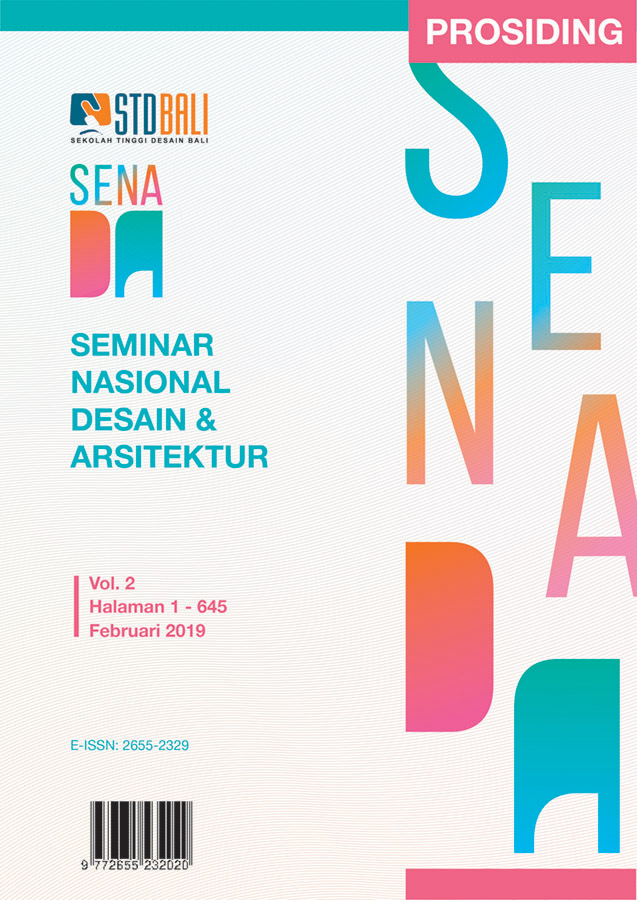SENI, DESAIN DAN KEBUDAYAAN DALAM SPIRIT REVOLUSI INDUSTRI 4.0
Keywords:
Industrial Revolution 4.0, Creative Destruction, Art, Design, CultureAbstract
The arrival of the fourth wave of the industrial revolution, called the Industrial Revolution 4.0, which was supported by the development of digital information technology, has influenced the development of art, design and culture. At least, there are three main factors that influence this development. First, the development of digital information technology, and "digitalization" of almost all sectors of life, especially economic and industrial aspects. Second, the development of a network society, which makes networking work as the main way of working today. Third, the development of the workings of collaboration, as a logical consequence of the development of networking communities. This study aims to reveal the influence of these three main factors in the development of art, design and culture. The study shows the development of the Industrial Revolution 4.0, the power of digital networks and networking communities, the growth of the Internet of Things (IoT) and other modern digital information technologies, the phenomenon of technological disruption, the power of destruction of innovation, and the role of art and design in creating disruptive ideas, understood as an inseparable and interrelated unity. Everything must be understood as a set of interrelated and interconnected phenomena, which if they fail to understand one causes failure in understanding the other. Through comprehensive and integrated understanding, a "big picture" can be described about what radical changes and fundamentals are taking place.
Downloads
References
Alp Ustundag and Emre Cevikcan, Industry 4.0: Managing The Digital Transformation, Springer, Cham, 2018, hlm. 4.
C.J. Bartodziej, The Concept Industry 4.0. hlm.5
Adrian McEwen and Hakim Cassimally, Designing the Internet of Things, John Wiley and Sons, Ltd., 2014, hlm. 9-10
Christopher Morace, Transform: How Leading Companies Are Winning with Disruptive Social Media, McGraw Hill, New York, 2014, hlm. 33
Hendrique Schneider, Creative Destruction and the Sharing Economy: Uber as Disruptive Innovation, Edward Elgar Publishing, Cheltenham, 2017, hlm. 68
Joseph A. Schumpeter, Capitalism, Socialism and Democracy, Routledge, London, 2003, hlm. 80
Clayton M. Christensen, The Innovator’s Dilemma: When New Technologies Cause Great Firms to Fail, Harvard Business School Press, Boston,1997, hlm. 11
Michael Flavin, Disruptive Technology Enhanced Learning The Use and Misuse of Digital Technologies in Higher Education, Palgrave, London, 2017, hlm.2
Peter F. Cowhey and Jonathan D. Aronson, Digital DNA: Disruption and the Challenges for Global Governance, Oxford University Press, Oxford, 2017, hlm.24
Henrique Schneider, Creative Destructionand the Sharing Economy, hlm. 2
Ibid.hlm.75
Paul Paetz, Disruption by Design: How to Create Products that Disrupt and then Dominate Markets, Apress, 2014, hlm.6
Tatiana Bazzichelli, Networking: The Net as Artwork, Digital Aesthetics Research Center, Milan, 2008, hlm. 26-27
Katja Kwastek, Aesthetics of Interaction in Digital Art, The MIT Press, Massachusetts, 2013, hlm. xvii
Paul Paetz, Disruption by Design, hlm. xv
Adrian McEwen and Hakim Cassimally, Designing the Internet of Things, hlm. 9-10
Ibid., hlm.79
Bruce Sterling, Shaping Things, The MIT Press, Massachusetts, 2005, hlm. 9-11






